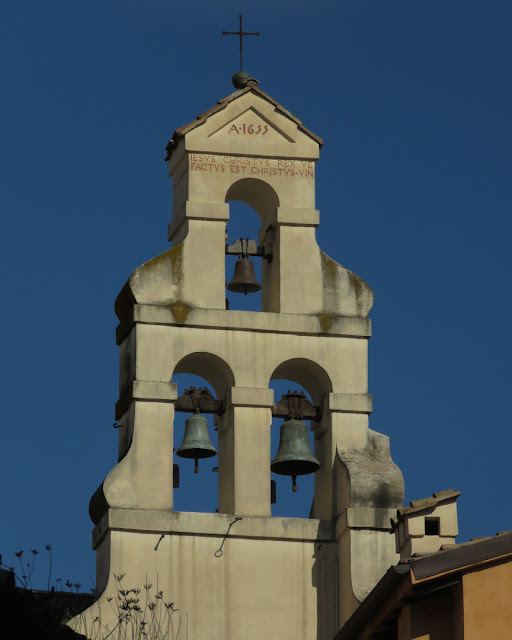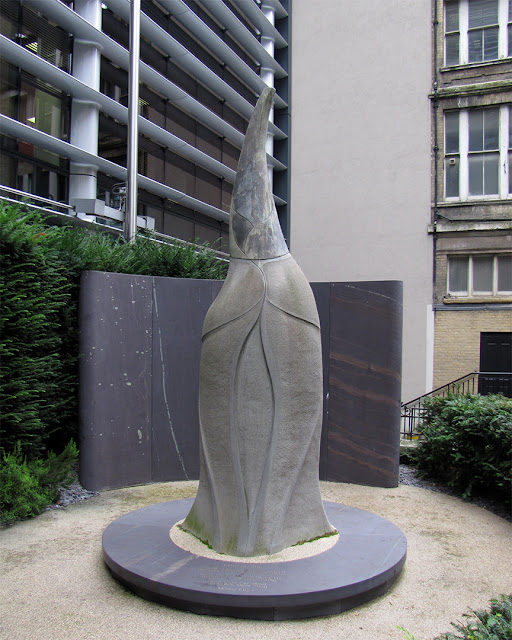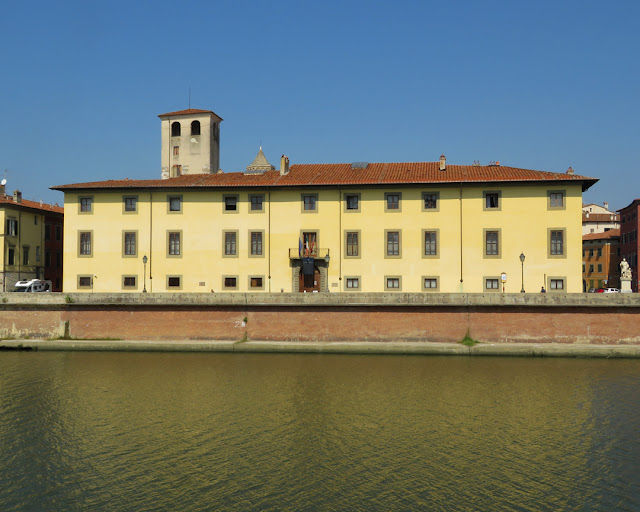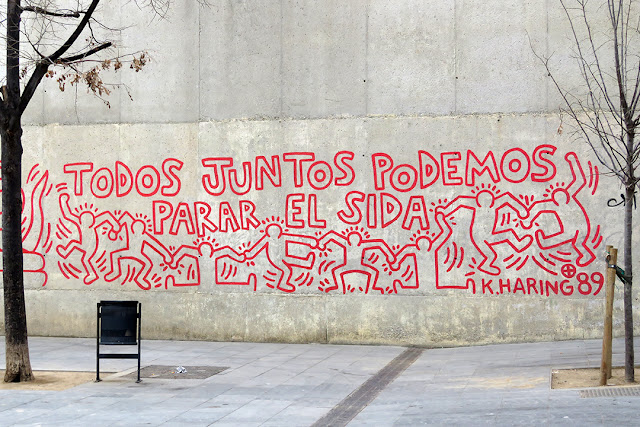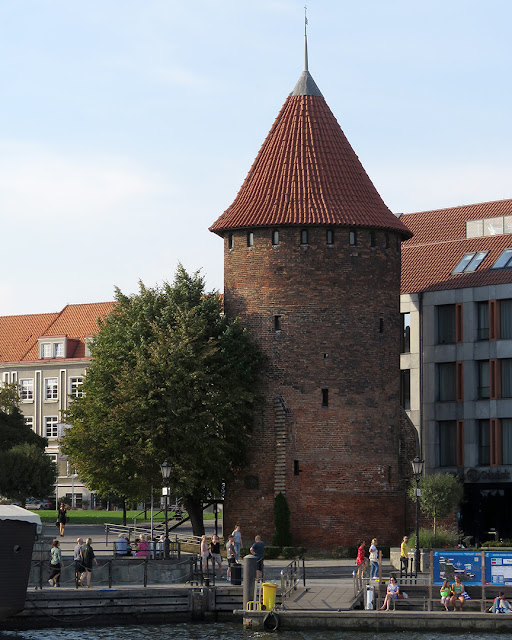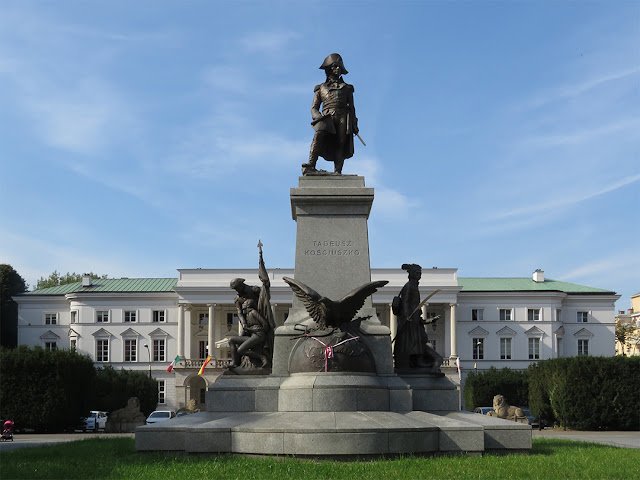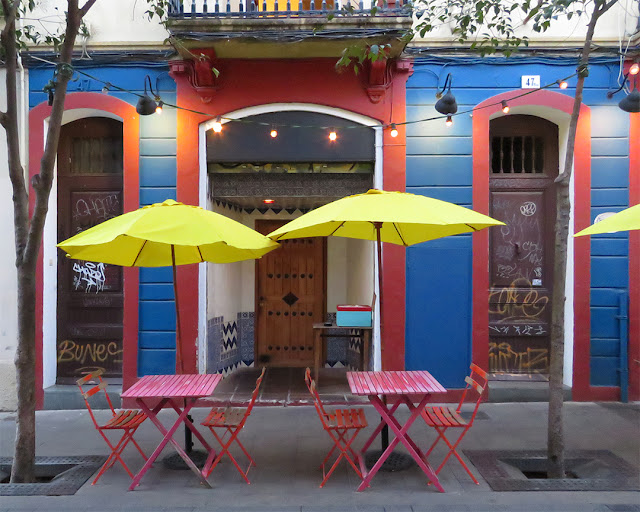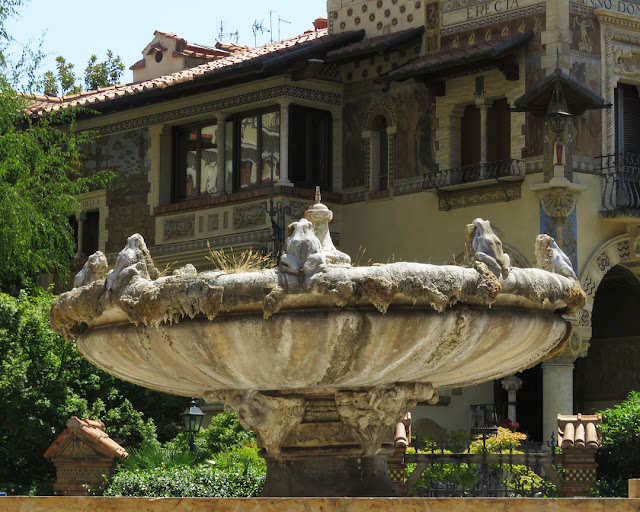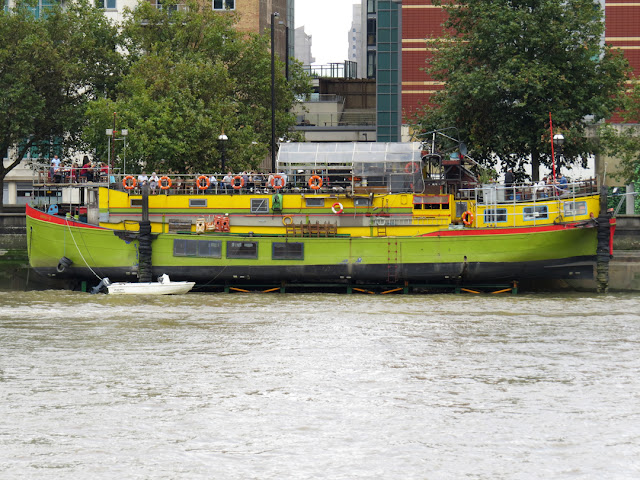Thursday, March 31, 2022
Carrer de les Egipcíaques
Carrer de les Egipcíaques
El Raval
Barcelona, March 2017
“On Egipcíaques Street, there was established, in 1670, a convent for women of ‘bad reputation’ which, having had a libertine life, hoped to distance themselves from vice and live out a life of exemplary conduct, as did Saint Mary Egipcíaca from whom the convent got its name. In 1679, the Casa de les Egipcíaques (House of the Egipcíaques) was also referred to as the ‘monastery of damsels’ or ‘room of damsels’ and used as a women's prison. Today, the building in Egipcíaques street dates from 1952 and 1954 and it is the headquarters of the Spanish Scientific Reasearch Council in Catalonia.” (Convent de les Egipcíaques, Route You)
Wednesday, March 30, 2022
Santa Maria dell'Umiltà
Santa Maria dell'Umiltà
Via dell'Umiltà
Rome, September 2019
“This is a small church, on a simple rectangular plan with a little square apse and four side niches functioning as chapels, two on each side. The exterior is inserted into one wing of the convent, and so is invisible from the street. There is a campanile, erected in 1655 over the right hand side wall. It is in the form of two little triumphal arches, one on top of the other; the lower has two archways, and the upper just one. Over the upper arch is a little triangular pediment. The three bells fit into the arches.” (Santa Maria dell'Umiltà, Churches of Rome Wiki)
Tuesday, March 29, 2022
Monday, March 28, 2022
Catrin Glyndŵr
Memorial to Catrin Glyndŵr by Richard Renshaw, 2001
St Swithin's Church Garden
Salters Hall Court, City of London
London, September 2014
“Catrin ferch Owain Glyndŵr (died 1413) was one of the daughters (probably the eldest) of Margaret Hanmer and Owain Glyndŵr, and her marriage to a claimant on the English throne was used by her father to gain support. Catrin is one of the children of Owain Glyndŵr about whom most is known. In November 1402, she married Edmund Mortimer, an unransomed hostage who entered into an alliance with her father. Edmund Mortimer died during the siege of Harlech Castle in 1409, of unknown causes. Catrin was subsequently captured alongside her three daughters. They, as well as her mother and one of her sisters, were taken to the Tower of London. The deaths of Catrin and her daughters are recorded, and their burial at St Swithin's Church in London, but the cause of their deaths is not known. A memorial to Catrin stands in St Swithin's Church Garden, where the church formerly stood; the statue was designed by Nic Stradlyn-John and sculpted by Richard Renshaw, and was unveiled in 2001 by Siân Phillips. Her mother's fate is not known; it is known only that Margaret Hanmer outlived Catrin. In 2003 an exhibition was held at the National Library of Wales to celebrate Catrin's legacy, and a short poem was composed in her memory by Menna Elfyn. A play, Catrin Glyndwr by Heledd Bianchi, was premièred in 2004.” (Catrin ferch Owain Glyndŵr, Wikipedia)
Sunday, March 27, 2022
Palazzo Reale
Palazzo Reale (Royal Palace) by Bernardo Buontalenti, 1583
Lungarno Pacinotti
Pisa, September 2020
“Built between 1583 and 1587 by will of the Grand Duke Francis I de’ Medici, to a plan by the Florentine architect Bernardo Buontalenti, the palace is situated in a prestigious area of Pisa, where the residence of the Marquis of Tuscia stood in the 10th century. Several already existing buildings were incorporated into the new one, among which were the tower known as "della Vergadoro" (Golden Rod) that belonged to the important Gaetani family, some towers (case torri) belonging to the Dodi e dei Gusmari coteries, and the "del Cantone" tower, most of the structure of which is still visible between via S. Nicola and via S. Maria. Several buildings, workshops and even a church were demolished to make way for the new palace and the adjacent piazza Carrara. In the18th and 19th centuries the palace continued to be the residence of the Grand Dukes of Tuscany. Peter Leopold I particularly enjoyed spending the winter here because of the mild climate. After the unification of Italy, the Savoy family occasionally stayed here, giving it its present name. The appearance of the palace is the result of several fairly recent additions and renovations. Bombing during the second world war destroyed the northern part as well as one of the overhead bridges used by the Grand Dukes to go to mass in the church of S. Nicola, but it was recently completely rebuilt, during repairs to the building. On the via S. Maria side there is another overhead bridge that survived, connecting the palace to palazzo delle Vedove. The building, now the offices of the Soprintendenza per i Beni A.P.P.S.A.E. of Pisa and Livorno, holds the Museo Nazionale di Palazzo Reale collections.” (Palazzo Reale, Turismo Pisa)
Saturday, March 26, 2022
Smoleńsk Air Disaster Monument
Smoleńsk Air Disaster Monument, 2018
plac marsz. Józefa Piłsudskiego
Warsaw, September 2018
“On 10 April 2018, exactly eight years after the 2010 Smoleńsk air disaster in which 96 people died, including the then President of Poland, Lech Kaczyński, and his wife Maria, a new monument was finally unveiled to commemorate those who died in the tragedy. After years of deliberation, Piłsudski Square was chosen as the location from among other potential candidates, with the Presidential Palace (among others) at one point being suggested. The form and design of the monument was not known until the day of the unveiling, having been hidden from view under a white tent during its construction. The black granite monument, built to look like the gangway stairs of a plane, has inevitably led to suggestions that it looks like a 'stairway to heaven'. A few months later, on 10 November, a monument to late President Lech Kaczyński was also unveiled, overlooking the square.” (Smoleńsk Air Disaster Monument, In Your Pocket)
Friday, March 25, 2022
Todos juntos
“Todos juntos podemos parar el sida”
(Together We Can Stop AIDS) by Keith Haring, 1989
Plaça de Joan Coromines
Barcelona, March 2017
“Todos Juntos Podemos Parar el SIDA (English: Together We Can Stop AIDS) is a mural created by American artist and social activist Keith Haring in 1989. The mural was painted to raise awareness to the Aids epidemic. It is located next to the Museu d'Art Contemporani de Barcelona museum in the El Raval neighborhood of Barcelona.” (Todos Juntos Podemos Parar el SIDA, Wikipedia)
Thursday, March 24, 2022
Piazza Navona
Church of Sant'Agnese in Agone
Piazza Navona
Rome, September 2019
“Piazza Navona is a public open space in Rome, Italy. It is built on the site of the Stadium of Domitian, built in the 1st century AD, and follows the form of the open space of the stadium. The ancient Romans went there to watch the agones (games), and hence it was known as ‘Circus Agonalis’ (competition arena). It is believed that over time the name changed to in avone to navone and eventually to navona.” (Santa Maria in Trastevere, Wikipedia)
Wednesday, March 23, 2022
The Banks of the Vistula
The Banks of the Vistula
bulwar Czerwieński
Stare Miasto (Old Town)
Kraków, September 2018
“If Wawel Castle is the spiritual heart of Poland, the Vistula River is its lifeblood, from a source of irrigation and trade to a setting for recreation and entertainment. Called the ‘Queen of Polish Rivers,’ the Vistula gathers waters from the southern mountains near Krakow and stretches them peacefully over a thousand kilometres to the Baltic Sea in the far north at Gdańsk. Although peaceful most days, the river sweeps up more than half of the water in the country and frequently reminds residents of their feeble attempts to pacify it.” (The Vistula/Wisła River, InYourPocket)
Tuesday, March 22, 2022
Monday, March 21, 2022
Pisa Cathedral
Cathedral of Santa Maria Assunta
Piazza dei Miracoli (Piazza del Duomo)
Pisa, September 2020
“Pisa Cathedral (Italian: Cattedrale Metropolitana Primaziale di Santa Maria Assunta; Duomo di Pisa) is a medieval Roman Catholic cathedral dedicated to the Assumption of the Virgin Mary, in the Piazza dei Miracoli in Pisa, Italy, the oldest of the three structures in the plaza followed by the Pisa Baptistry and the Campanile known as the Leaning Tower of Pisa. The cathedral is a notable example of Romanesque architecture, in particular the style known as Pisan Romanesque. Consecrated in 1118, it is the seat of the Archbishop of Pisa. Construction began in 1063 and was completed in 1092. Additional enlargements and a new facade were built in the 12th century and the roof was replaced after damage from a fire in 1595.” (Pisa Cathedral, Wikipedia)
Sunday, March 20, 2022
Saturday, March 19, 2022
Santa Maria de Montalegre
Santa Maria de Montalegre
Carrer de Valldonzella
Barcelona, March 2017
“The construction of the church was carried out in 1901-1902 on the site of the old chapel. The opening of the shrine took place to commemorate the centenary of the House of Mercy. During the Spanish Civil War, the church was damaged and used as a hospital and grocery store. Then the restoration of the shrine was carried out, and the opening took place in 1940. In 1952, on the occasion of the 150th anniversary of the Casa de la Caritate and the 50th anniversary of the church, the current image of the presbytery, created by Jaume Busquets y Mollera, was installed. Today the church has a Roman cross in the plan. It stands out with rosette windows and a monumental arched portal (entrance). Casa de la Caritat is a renovated complex of buildings in a modernist style with a courtyard. The premises currently house a cultural complex consisting of various institutions.” (Church of St. Mary in Barcelona, life-globe.com)
Friday, March 18, 2022
Università Gregoriana
Pontificia Università Gregoriana (Pontifical Gregorian University)
Piazza della Pilotta
Rome, September 2019
“The Pontifical Gregorian University (Italian: Pontificia Università Gregoriana; also known as the Gregorian or Gregoriana) is a higher education ecclesiastical school (pontifical university) located in Rome, Italy. The Gregorian originated as a part of the Roman College, founded in 1551 by Ignatius of Loyola, and included all grades of schooling. Its chairs of philosophy and theology received given Papal approval in 1556, making it the first institution founded by the Society of Jesus (Jesuits). In 1584, the Roman College was given a new home by Pope Gregory XIII, after whom it was renamed the Gregorian University. It had distinguished scholars in ecclesiastical fields as well as in natural science and mathematics. Only the theology and philosophy departments of the Gregorian survived the political turmoil in Italy after 1870. Today, the Gregorian has an international faculty and around 2,750 students from over 150 countries.” (Pontifical Gregorian University, Wikipedia)
Thursday, March 17, 2022
Tadeusz Kościuszko Monument
Tadeusz Kościuszko Monument by Antoni Popiel, 1910
Plac Żelaznej Bramy
Warsaw, September 2018
“The Tadeusz Kościuszko Monument in Warsaw (Polish: Pomnik Tadeusza Kościuszki w Warszawie) is a statue dedicated to commemorate the national hero of Poland, Lithuania, Belarus, and the United States, general Tadeusz Kościuszko (1746–1817), and situated on the Iron-Gate Square in front of the Lubomirski Palace. It stands on the main axis of the historical city centre of Warsaw, the Saxon Axis. The monument is an exact copy of the Statue of Tadeusz Kościuszko at Lafayette Square in Washington, D.C. unveiled on 9 May 1910, and designed by the Polish sculptor Antoni Popiel (1865–1910). The monument replaced the former monument of the ‘Dead in the Service and Defense of the Polish People's Republic’, erected in the 1980s by the Communist government and demolished 1991. The investment was financed by the Citi Bank Handlowy and the Warsaw City Council. The bronze elements of the monument were moulded by the Technical Appliance Works at Gliwice. The copying of the Washington monument was executed by Kraków sculptors Anna and Wojciech Siek. The monument was unveiled on 16 November 2010. The monument shows the figure of Tadeusz Kościuszko in the uniform of an American general, holding drawings of the West Point garrison defenses in his hand. On the right side of the monument stands a figure symbolizing the Battle of Racławice and on the left side a figure symbolizing the Battle of Saratoga.” (Tadeusz Kościuszko Monument, Wikipedia)
Wednesday, March 16, 2022
St Dunstan's College
St Dunstan's College plaque
St Dunstan's Garden
St Dunstan's Hill, City of London
London, September 2014
“The church was severely damaged in the Blitz of 1941. Wren's tower and steeple survived the bombs' impact. Of the rest of the church only the north and south walls remained. In the re-organisation of the Anglican Church in London following the War it was decided not to rebuild St Dunstan's, and in 1967 the City of London Corporation decided to turn the ruins of the church into a public garden, which opened in 1971. A lawn and trees were planted in the ruins, with a low fountain in the middle of the nave. The tower now houses the All Hallows House Foundation. The parish is now combined with the Benefice of All Hallows by the Tower and occasional open-air services are held in the church, such as on Palm Sunday prior to a procession to All Hallows by the Tower along St Dunstan's Hill and Great Tower Street. The ruin was designated a Grade I listed building on 4 January 1950.” (St Dunstan-in-the-East, Wikipedia)
Tuesday, March 15, 2022
Monday, March 14, 2022
Kościół Mariacki
Kościół Mariacki (Saint Mary’s Basilica)
Rynek Główny (Main Square)
Stare Miasto (Old Town)
Kraków, September 2018
“Saint Mary’s Basilica (Polish: Kościół Mariacki) is a Brick Gothic church adjacent to the Main Market Square in Kraków, Poland. Built in the 14th century, its foundations date back to the early 13th century and serve as one of the best examples of Polish Gothic architecture. Standing 80 m (262 ft) tall, it is particularly famous for its wooden altarpiece carved by Veit Stoss (Wit Stwosz). Some of its monumental polychrome murals were designed by Poland's leading history painter, Jan Matejko (1898-1891). In 1978 it became a UNESCO World Heritage Site alongside the Historic Centre of Kraków. On every hour, 24 hours a day, 365 days a year, a trumpet signal—called the Hejnał mariacki—is played from the top of the taller of Saint Mary's two towers. The plaintive tune breaks off in mid-stream, to commemorate a famous 13th century trumpeter who was shot in the throat while sounding the alarm before a Mongol attack on the city. The noon-time hejnał is heard across Poland and abroad broadcast live by the Polish national Radio 1 Station. Saint Mary's Basilica also served as an architectural model for many of the churches that were built by the Polish diaspora abroad, particularly those like Saint Michael's and Saint John Cantius in Chicago, designed in the Polish Cathedral style.” (St. Mary's Basilica, Wikipedia)
Sunday, March 13, 2022
Saturday, March 12, 2022
Fontana delle Rane
Fontana delle Rane (Fountain of the Frogs) by Gino Coppedè, 1924
Piazza Mincio, Quartiere Coppedè
Rome, June 2019
Friday, March 11, 2022
The Brave One
“The Brave One” billboard
W Houston Street
New York, September 2007
“The Brave One is a 2007 psychological thriller film directed by Neil Jordan and written by Roderick Taylor, Bruce A. Taylor and Cynthia Mort. The film stars Jodie Foster as Erica Bain, a New York City radio host whose partner is beaten to death by criminals. Terrified for her safety, she buys a pistol and undergoes a personality transformation, becoming a vigilante. Detective Sean Mercer (Terrence Howard) investigates the vigilante shootings, which lead him closer and closer to Bain. The film features Naveen Andrews, Nicky Katt, Zoë Kravitz, Mary Steenburgen and Luis Da Silva in supporting roles. The Brave One was released in the United States on September 14, 2007. The film received mixed reviews from critics who acclaimed Foster's performance but criticized its execution. It was a box office disappointment grossing $69 million worldwide. At the 65th Golden Globe Awards, Foster received a nomination for Best Actress Motion Picture in a Drama.” (The Brave One, Wikipedia)
Thursday, March 10, 2022
Tamesis Dock
Tamesis Dock floating pub
Albert Embankment, Vauxhall
London, September 2014
“If you stroll west along the Thames, you’ll find Tamesis Dock – an old converted barge, brimming with the buzzing sound of bands and boozing. Moored between Lambeth and Vauxhall Bridge, this converted 1930s Dutch barge-turned-pub has just about everything you might need for just about any occasion. Catch a live gig, make your way through the never-ending selection of beers, or join the avid crowd of brunchers at the weekend. Join them for Ukulele Wednesdays or Funky Fridays, or just go and enjoy a few bevvys on the top deck. You may even catch the odd gig at the venue, too (they’ve previously hosted the likes of Bastille and Local Natives) – but keep an eye on Tamesis Dock’s Facebook page to stay up to date with their upcoming events. The barge boasts epic views of the Houses of Parliament, the London Eye and Battersea Power Station, but its interiors aren’t a sorry sight either. It’s hella quirky and extremely cosy down below, while the top deck is a dream in the summer.” (Tamesis Dock, Secret London)
Wednesday, March 9, 2022
Baptistery of St. John
Battistero di San Giovanni (Baptistery of St. John)
Piazza dei Miracoli (Piazza del Duomo)
Pisa, September 2020
“The Pisa Baptistery of St. John (Italian: Battistero di San Giovanni) is a Roman Catholic ecclesiastical building in Pisa, Italy. Construction started in 1152 to replace an older baptistery, and when it was completed in 1363, it became the second building, in chronological order, in the Piazza dei Miracoli, near the Duomo di Pisa and the cathedral's free-standing campanile, the famous Leaning Tower of Pisa. The baptistery was designed by Diotisalvi, whose signature can be read on two pillars inside the building, with the date 1153.” (Pisa Baptistery, Wikipedia)
Tuesday, March 8, 2022
St. Mary's Street
Ulica Mariacka (St. Mary's Street)
Mariacka
Stare Miasto (Old Town)
Gdańsk, September 2018
“The most atmospheric of all Gdańsk's streets and one of Poland’s most photogenic lanes is this length of cobbles between the waterfront St Mary’s Gate and the red-brick hulk of St Mary’s Church. Almost completely re-created after WWII, mostly on the basis of old documents, photographs and illustrations, every ornamental detail unearthed from the debris, including countless scary gargoyles, was incorporated. It’s the only street with a complete row of terraces, which lends the scene enormous charm. In recent years things have really come to life, with several artisan amber jewellery shops, some great cafes and bars, and one of northern Poland’s most characterful hotels (Kamienica Gotyk). Some of the best stalls are set up here during the Dominican Fair.” (Ulica Mariacka, Lonely Planet)
Monday, March 7, 2022
Llibreria Pròleg
Llibreria Pròleg (Bookstore)
Carrer de Sant Pere Més Alt
Barcelona, March 2017
“The Llibreria Pròleg bookshop is Barcelona's epicenter of feminism and the struggle for equal rights and opportunities for women in the city. Since 2009 it has occupied this location in Carrer Sant Pere Més Alt. Pròleg is much more than a bookstore with books about women and by women. Open and critical in its approach, here we can find books for children and young people that are free of sexist criteria, an exhaustive essay section, and even interesting workshops and collective activities.” (Llibreria Pròleg, Visit Barcelona)
Sunday, March 6, 2022
Altare della Patria
Altare della Patria (Altar of the Fatherland) by Giuseppe Sacconi, 1911
Piazza Venezia
Rome, September 2019
“The Victor Emmanuel II National Monument (Italian: Monumento Nazionale a Vittorio Emanuele II), also known as the Mole del Vittoriano or simply Vittoriano, is a large national monument built between 1885 and 1935 to honour Victor Emmanuel II, the first king of a unified Italy, in Rome, Italy. It occupies a site between the Piazza Venezia and the Capitoline Hill. It is currently managed by the Polo Museale del Lazio and is owned by the Ministry of Cultural Heritage and Activities. From an architectural perspective, it was conceived as a modern forum, an agora on three levels connected by stairways and dominated by a portico characterized by a colonnade. The complex process of national unity and liberation from foreign domination carried out by King Victor Emmanuel II of Savoy, to whom the monument is dedicated, has a great symbolic and representative value, being architecturally and artistically centred on the Italian unification—for this reason the Vittoriano is considered one of the national symbols of Italy. It also preserves the Altar of the Fatherland (Italian: Altare della Patria), first an altar of the goddess Rome, then also a shrine of the Italian Unknown Soldier, thus adopting the function of a lay temple consecrated to Italy. Because of its great representative value, the entire Vittoriano is often called the Altare della Patria, although the latter constitutes only a part of the monument.” (Victor Emmanuel II Monument, Wikipedia)
Saturday, March 5, 2022
Friday, March 4, 2022
Thursday, March 3, 2022
Leaning Tower of Pisa
Leaning Tower of Pisa
Piazza dei Miracoli (Piazza del Duomo)
Pisa, September 2020
“The Leaning Tower of Pisa (Italian: torre pendente di Pisa), or simply the Tower of Pisa (torre di Pisa), is the campanile, or freestanding bell tower, of the cathedral of the Italian city of Pisa, known worldwide for its nearly four-degree lean, the result of an unstable foundation. The tower is situated behind the Pisa Cathedral and is the third-oldest structure in the city's Cathedral Square (Piazza del Duomo), after the cathedral and the Pisa Baptistry. The height of the tower is 55.86 metres (183 feet 3 inches) from the ground on the low side and 56.67 m (185 ft 11 in) on the high side. The width of the walls at the base is 2.44 m (8 ft 0 in). Its weight is estimated at 14,500 tonnes (16,000 short tons). The tower has 296 or 294 steps; the seventh floor has two fewer steps on the north-facing staircase. The tower began to lean during construction in the 12th century, due to soft ground which could not properly support the structure's weight, and it worsened through the completion of construction in the 14th century. By 1990, the tilt had reached 5.5 degrees. The structure was stabilized by remedial work between 1993 and 2001, which reduced the tilt to 3.97 degrees.” (Leaning Tower of Pisa, Wikipedia)
Wednesday, March 2, 2022
Bazylika Świętej Trójcy
Bazylika Świętej Trójcy (Basilica of Holy Trinity)
Stolarska
Stare Miasto (Old Town)
Kraków, September 2018
“The Basilica of Holy Trinity (Polish: Bazylika Świętej Trójcy) in Kraków, Poland, is a gothic church and monastery of the Dominican Order. Its history dates from the year 1223. Saint Hyacinth is buried in the church, as well as Polish monarch Leszek II the Black and Renaissance humanist Filippo Buonaccorsi.” (Basilica of Holy Trinity, Wikipedia)
Subscribe to:
Posts (Atom)


